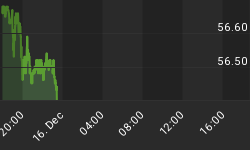The Fidelity mutual fund organization spends millions on research and "expert" personnel each year. They can afford the best consultants, portfolio managers, analysts, economists and technology. They take on the task of providing superior investment performance throughout their fund family with dedication, hard work and sincerity.
In the end, it doesn't amount to much.
You'd think that all of these resources applied to a single problem would generate something to brag about. Alas, it just isn't so.
The chart below shows some of Fidelity's largest funds plotted against the S&P 500 over the past ten years. Not a pretty picture.
As you can see, the funds depicted closely tracked their benchmark index for better or worse - in this case, worse. So, the proper conclusion to be drawn from this is that all the deep research, sincere cogitation, and expensive technology employed over the past decade added up to zero. Investors would have done as well throwing darts at stock names.
Now, I'm not writing this to beat up on Fidelity. It's an industry-wide disease. In the chart below there are samples from some of the biggest organizations in the mutual fund industry, including two of the best performing funds.
The offerings which cluster around the S&P 500 were all, at one time, highly regarded for their superior performance. The Growth Fund of America is one of the top ten holdings in 401(k) plans nationwide, as is the Dodge and Cox Stock Fund. This fund and the Ariel Fund did much better than average over the decade, but that was due almost wholly to their focus on the value sector of the market. When that sector collapsed in 2008, these great performers gave up all their multi-year gains in sixteen months. Clearly their research, dedicated experts, and advanced technology didn't help them either. Sic transit gloria mundi.
"But wait", you say, "What about that index that has done so well over the past decade - the S&P 400 Power Index?"
Oh, that old thing - it's just a simple formula that requires no fancy technology, no high-paid research analysts, no deep economic analysis. Here it is: buy the S&P MidCap 400 Index on October 31, sell at the end of May and hold intermediate treasury bonds the remainder of the time. Repeat religiously every year and relax.
Of course, following this formula requires you to give up all the intellectual pretensions that are worshiped by the folks at Fidelity, Oppenheimer, Janus, and most investment "experts". You'll have to admit to yourself that economics is a mystery that you can't unravel, that you can't pick superior stocks or industries consistently, and that your intuitions about the stock market are routinely off-track and unlikely to get better.
In other words, you'll have to confess that, like the folks at Fidelity, these pursuits will not lead you to superior investment outcomes.
But on the other hand, here's something you can feel confident about: human nature is predictable. This means that at year-end, high-paid stock analysts will generally ooze optimism about the next twelve months, causing investors to assume more risk and bolstering the positive climate for stocks. At mid-year, these same analysts normally will be forced by reality to retreat from their earlier overly-optimistic predictions and downgrade their estimates. Over the course of years, this repeating cycle of human error "skews" market returns into the annual "power zone", causing all of the long-term returns of the market to be contained in the six to seven month period from November through May while increasing the likelihood of market corrections during the June through October period.
You will also have the satisfaction of knowing that this has been going on in all developed stock markets since World War II.* Best of all, you know that as an investor you can exploit this cycle and your patience will be rewarded by the flaws of human nature which makes it all possible.
To get a detailed look at the 29-year history of this effect on the mid-cap index, and the 60-year history of the cycle on the Dow Industrials, download the Alpha Mid-Cap Power Index Managed Account brochure at the Programs and Performance section of our website at www.alphaim.net.
If you would like to discuss how this strategy might apply to your portfolio, please contact me at 877-229-9400, Ext. 11 or minton@alphaim.net.


















